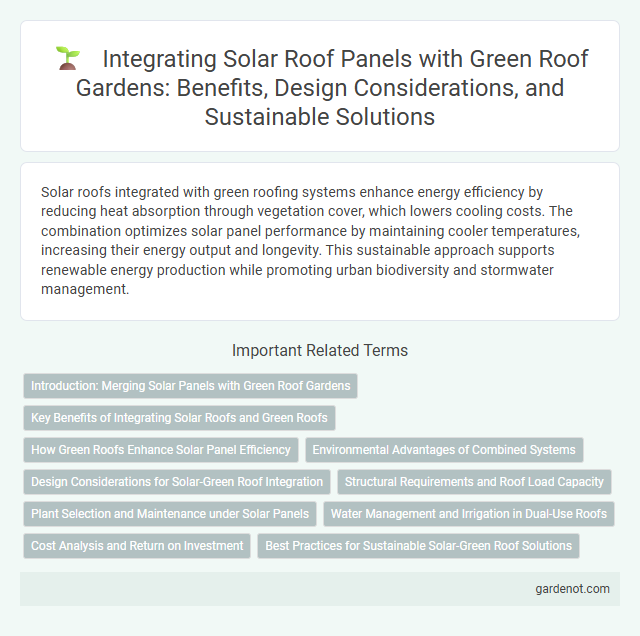Solar roofs integrated with green roofing systems enhance energy efficiency by reducing heat absorption through vegetation cover, which lowers cooling costs. The combination optimizes solar panel performance by maintaining cooler temperatures, increasing their energy output and longevity. This sustainable approach supports renewable energy production while promoting urban biodiversity and stormwater management.
Introduction: Merging Solar Panels with Green Roof Gardens
Integrating solar panels with green roof gardens creates a sustainable energy solution that enhances building efficiency and environmental benefits. This synergy improves energy generation by cooling solar panels through vegetation, increasing their performance and lifespan. Combining renewable energy production with urban greening reduces carbon footprints and supports biodiversity in metropolitan areas.
Key Benefits of Integrating Solar Roofs and Green Roofs
Integrating solar roofs with green roofs enhances energy efficiency by combining photovoltaic energy production with natural insulation and cooling from vegetation. This duo reduces urban heat island effects while lowering electricity costs and improving air quality through carbon sequestration. The synergy also extends roof lifespan by protecting solar panels and roofing materials from extreme weather and UV damage.
How Green Roofs Enhance Solar Panel Efficiency
Green roofs reduce ambient temperatures around solar panels by providing natural insulation and shading, which minimizes heat stress and improves photovoltaic performance. The cooler microclimate created by vegetation helps maintain optimal solar panel temperatures, increasing energy conversion efficiency by up to 15%. Integrating green roofs with solar installations also mitigates urban heat island effects, further boosting the overall sustainability and effectiveness of solar energy systems.
Environmental Advantages of Combined Systems
Combined green and solar roof systems significantly reduce urban heat island effects by enhancing roof insulation and increasing albedo, leading to lower ambient temperatures. These integrated systems improve energy efficiency by reducing cooling and heating demands, resulting in substantial greenhouse gas emission reductions. Enhanced stormwater management from vegetation combined with renewable energy generation contributes to sustainable urban ecosystems and resilience against climate change.
Design Considerations for Solar-Green Roof Integration
Design considerations for solar-green roof integration prioritize optimal sunlight exposure and structural load capacity to ensure efficient energy production and roof stability. Incorporating greenery with photovoltaic panels requires selecting lightweight, drought-resistant plants that do not shade solar modules while maintaining adequate drainage systems. Electrical wiring and mounting systems must be corrosion-resistant and compatible with the green roof substrate to maximize durability and performance.
Structural Requirements and Roof Load Capacity
Solar roofs require robust structural support to accommodate the additional weight of photovoltaic panels and mounting systems, ensuring stability and safety. The roof load capacity must be evaluated to confirm it can sustain both the static load of solar equipment and dynamic forces such as wind and snow. Engineering assessments often include load calculations, reinforcement strategies, and compliance with local building codes to optimize performance and longevity.
Plant Selection and Maintenance under Solar Panels
Selecting shade-tolerant, drought-resistant plants such as sedums, ferns, and ornamental grasses ensures optimal growth beneath solar panels on green roofs. Regular maintenance includes monitoring soil moisture, removing invasive species, and periodic pruning to prevent shading of solar panels and maintain energy efficiency. Integrating native plant species enhances biodiversity while promoting resilience in the unique microclimate created by solar panel shading.
Water Management and Irrigation in Dual-Use Roofs
Dual-use solar roofs integrate photovoltaic panels with green roofing systems to optimize water management and irrigation efficiency. These systems capture rainwater and use it to irrigate vegetation beneath solar arrays, reducing runoff and enhancing plant health. Incorporating smart irrigation controls and moisture sensors maximizes water conservation while maintaining solar panel performance.
Cost Analysis and Return on Investment
Solar roofs typically require an initial investment ranging from $15,000 to $30,000, influenced by panel size, installation complexity, and location. Energy savings average 20-30% on electricity bills annually, translating to a return on investment within 7 to 12 years. Federal tax credits, local incentives, and reduced maintenance costs enhance the overall financial benefits of installing solar roofing systems.
Best Practices for Sustainable Solar-Green Roof Solutions
Integrating solar panels on green roofs enhances energy efficiency while promoting urban biodiversity and reducing heat island effects. Best practices for sustainable solar-green roof solutions include selecting lightweight, durable photovoltaic materials, ensuring optimal panel orientation and tilt for maximum solar exposure, and using native, drought-resistant plants to support ecological balance and reduce irrigation needs. Incorporating automated irrigation and regular maintenance schedules further extends the lifespan and performance of both the solar system and vegetation.
Solar roof Infographic

 gardenot.com
gardenot.com